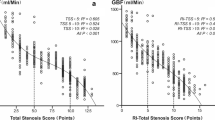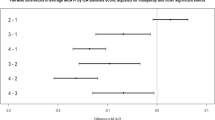Abstract
In order to evaluate whether the results of ultrasound examination may be associated with 30-day outcome, 76 consecutive patients (43 men and 33 women; mean age 68.1±8.9 years) underwent duplex scanning of the carotid bifurcations and transcranial doppler investigation of the basal skull arteries within the first few hours of the onset of an acute carotid stroke. Forty-three patients (56.6%) had appropriate arterial occlusion at ultrasounds examination. On day 30, 22 patients (28.9%) were self-sufficient, 41 (53.9%) were disabled and 13 (17.1%) were dead. The chisquared test showed that the ultrasound results were significantly related to 30-day outcome (p=.0003).
After logistic regression analysis, the ultrasound results remained independent predictors of 30-days outcome (p=.0129), together with neurological impairment 24 hours after stroke onset and lesion size at control computed tomography.
Our study suggests that the results of ultrasound examination may be useful in the management of acute carotid stroke as an early indicator of patients with a worse prognosis.
Sommario
Abbiamo sottoposto 76 pazienti consecutivi, di età media di 68.1±8.9 anni, ricoverati per un primo ictus ischemico nei territori carotidei, a studio ecodoppler delle biforcazioni carotidee e a doppler transcraniale delle arterie del basicranio, per valutare se le informazioni ricavate dagli studi ultrasonori potessero essere di aiuto a fini prognostici, 43 pazienti (56.6%) presentavano occlusione di una appropriata arteria agli ultrasuoni. A 30 giorni dall'ictus, 22 pazienti (28.9%) erano autosufficienti, 41 pazienti (53.9%) erano dipendenti e 13 pazienti (17.1%) erano morti.
Al test del Chi quadrato, i risultati degli ultrasuoni erano significativamente correlati alla prognosi a 30 giorni (p=.0003). Dopo analisi di regressione logistica multipla, i risultati degli ultrasuoni rimanevano indicatori prognostici indipendenti (p=.0129) insieme alle dimensioni della lesione ischemica alla TAC encefalo ripetuta tra il 4° e il 7° giorno dallo stroke e alla gravità neurologica a 24 ore dall'esordio dei sintomi. Il nostro studio suggerisce che gli ultrasuoni potrebbero essere utili nelle decisioni cliniche dei pazienti con stroke ischemico carotideo quali indicatori precoci di prognosi.
Similar content being viewed by others
References
Aaslid R., Markwalder T.M., Nornes H. Non-invasive transcranial ultrasound recording of flow velocity in basal arteries. J. Neurosurg. 57: 769–774, 1982.
Bamford J., Sandercock P.A.G., Warlow C.P., Slattery J.:Inter-observer agreement for the assessment of handicap in stroke patients. Stroke 20: 828, 1989.
Biller J., Love B.B., Marsh III E.E. et al.:Spontaneous improvement after ischemic stroke: a pilot study. Stroke 21: 1008–1012, 1990.
Brott T., Marler J., Olinger C.P. et al.:Measurements of acute cerebral infarction: lesion size by Computed Tomography. Stroke 20: 871–875, 1989.
Camerlingo M., Casto L., Censori B. et al.:Transcranial doppler in acute ischemic stroke of the middle cerebral artery territories. Acta Neurol. Scand. 88: 108–111, 1993.
Cattin F.:Ultrasonic exploration of the main supra-aortic arteries. J. Neuroradiol. 20: 155–161, 1993.
Censori B., Camerlingo M., Casto L. et al.:Prognostic factors in first-ever stroke in the carotid artery territory seen within 6 hours after onset. Stroke 24: 532–535, 1993.
Cotè R., Hachinski V.C., Shurwell B. et al.:The Canadian Neurological Scale: a preliminary study in acute stroke. Stroke 17: 731–736, 1986.
Davalos A., Cendra E., Teruel J. et al.:Deteriorating ischemic stroke: risk factors and prognosis. Neurology 40: 1865–1869, 1990.
Easton J.D., Sherman D.G.:Management of cerebral embolism of cardiac origin. Stroke 11: 433–442, 1980.
Fieschi C., Argentino C., Lenzi G.L. et al.:Clinical and instrumental evaluation of patients with ischemic stroke in the first 6 hours. J. Neurol. Sci. 91: 311–322, 1989.
Halsey J.H. Jr.:Prognosis of acute hemiplegia estimated by transcranial doppler ultrasonography. Stroke 19: 648–649, 1988.
Hedera P., Traubner P., Bujdakova J.:Short-term prognosis of stroke due to occlusion of internal carotid artery based on transcranial doppler ultrasonography. Stroke 23: 1069–1072, 1992.
Hennerici M., Freund H.J.:Efficacy of CW Doppler and Duplex System examinations for the evaluation of extracranial carotid disease. J. Clin. Ultrasound 12: 155–161, 1984.
Kaps M., Damian M.S., Teschendorf U., Dorndorf W.:Transcranial doppler ultrasound findings is middle cerebral artery occlusion. Stroke 21: 532–537, 1990.
Kuschner M.J., Zanette E.M., Bastianello S. et al.:Transcranial Doppler in acute hemispheric brain infarction. Neurology 41: 109–113, 1991.
Ley-Pozo J., Ringelstein E.B.:Non-invasive detection of the disease of the carotid siphon and middle cerebral artery. Ann. Neurol. 28: 640–647, 1990.
Lindegaard K., Bakke S., Aaslid R., Nornes H.:Doppler diagnosis of intracranial artery occlusive disorders. J. Neurol. Neurosurg. Psychiatry 49: 510–518, 1986.
Mattle H., Grolimund P., Huber P., Zurbrueff H.:Transcranial Doppler ultrasonographic findings in middle cerebral artery disease. Arch. Neurol. 45: 289–295, 1988.
Ringelstein E.B., Biniek P., Weiller C. et al.:Type and extent of hemispheric brain infarctions and clinical outcome in early and delayed middle cerebral artery recanalization. Neurology 42: 289–298, 1992.
VonKummer R., Hacke W.:Safety and efficacy of intravenous tissue plasminogen activator and heparin in acute middle cerebral artery stroke. Stroke 23: 646–652, 1992.
Zanette E.M., Fieschi C., Bozzao L. et al.:Comparison of cerebral angiography and transcranial doppler in acute stroke. Stroke 20: 899–903, 1989.
Zanette E.M., Roberti C., Mancini G. et al.:Spontaneous middle cerebral artery reperfusion in ischemic stroke. Stroke 26: 430–433, 1995.
Author information
Authors and Affiliations
Rights and permissions
About this article
Cite this article
Camerlingo, M., Casto, L., Censori, B. et al. Prognostic use of ultrasonography in acute non-hemorrhagic carotid stroke. Ital J Neuro Sci 17, 215–218 (1996). https://doi.org/10.1007/BF01995686
Received:
Accepted:
Issue Date:
DOI: https://doi.org/10.1007/BF01995686




